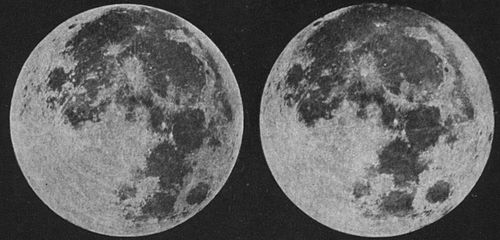3D photography
| Stereo image
|
|
|
|
|
Parallel view ( ) )
|
|
|
|
Cross-eye view ( ) )
|
|
|
|
| Midtown manhattan stereo photograph |
| Stereo image
|
|
|
|
|
Parallel view ( ) )
|
|
|
|
Cross-eye view ( ) )
|
|
|
|
| Hyperstereo example taken out from airplane while flying over Greenland
|
| Stereo image
|
|
|
|
|
Parallel view ( ) )
|
|
|
|
Cross-eye view ( ) )
|
|
|
|
| Moon stereo from 1897 taken using libration. |
| Stereo image
|
|
|
|
|
Parallel view ( ) )
|
|
|
|
Cross-eye view ( ) )
|
|
|
|
| Closeup stereo of a cake photographed using a Fuji W3. Taken by backing off several feet and then zooming in. |
Stereo photography techniques are methods to produce stereoscopic images, videos and films. This is done with a variety of equipment including special built stereo cameras, single cameras with or without special attachments, and paired cameras. This involves traditional film cameras as well as, tape and modern digital cameras. A number of specialized techniques are employed to produce different kinds of stereo images.
It is necessary to take two photographs from different horizontal positions to get a true stereoscopic image pair. This can be done with two separate side-by-side cameras; with one camera moved from one position to another between exposures; with one camera and a single exposure by means of an attached mirror or prism arrangement that presents a stereoscopic image pair to the camera lens; or with a stereo camera incorporating two or more side-by-side lenses.
Charles Wheatstone first began experimenting with stereopsis in 1838 using specially constructed drawings. The invention of photography in 1839 opened up a new and more detailed medium for his experiments and the first photographic stereoscopic pairs appeared in the early 1840s as Daguerreotypes and Calotypes. By the 1850s, a stereoscope and an assortment of professionally photographed stereo views were becoming part of the standard equipment of a properly furnished middle-class parlor. In the 1890s, photographic plates and films sensitive enough to make casual "snapshot" photography practical were available, and combined with easy-to-use cameras they were making amateur photography a very popular hobby. Stereo cameras were in the mix. The earliest were inconveniently large and the end result was a pair of paper prints mounted on a card for viewing in a standard stereoscope. They were soon joined by smaller cameras that yielded relatively small stereo slides on glass. The popularity of stereo photography declined after the First World War and plummeted during the Great Depression of the 1930s.
In the late 1940s, compact imported European stereo cameras that used 35 mm slide film began appearing in the US market. The most notable example was the Verascope F40. These cameras featured a "7P" format, meaning that each image was 7 film perforations (sprocket holes) wide, yielding 11 stereo pairs on a 20-exposure roll of 35 mm film. Because these cameras (and some later models) came from Europe, this became known as the "European format".
...
Wikipedia




